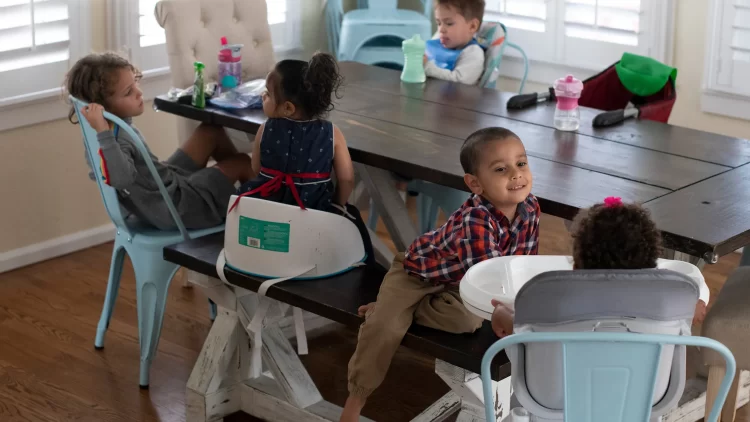Unveiling the Rich Tapestry of Home-Based Child Care
Introduction:
In the intricate landscape of early childhood education, home-based child care emerges as a distinctive thread, weaving together the warmth of a caregiver’s home with the fundamental aspects of childcare and early education. This comprehensive exploration delves into the nuanced realm of home-based child care, unveiling its unique attributes, the age group it caters to, the providers who shape its essence, and the integral role it plays in the holistic development of infants to preschool-aged children. From the intimate setting of a caregiver’s home to the personalized touch of family child care providers, this narrative seeks to illuminate the enriching experiences that unfold within the embrace of home-based child care.

Objectives of Home-Based Child Care:
- Creating a Nurturing Environment:
- Description: Home-based child care prioritizes creating a nurturing and intimate environment that mirrors the warmth of a family setting.
- Homely Atmosphere: Integration of familiar elements, such as home-cooked meals and personalized spaces, to provide comfort.
- Individualized Attention:
- Description: With smaller groups of children, home-based child care allows for individualized attention, catering to each child’s unique needs and developmental pace.
- Personalized Learning Plans: Tailoring activities and learning plans based on the interests and developmental stages of each child.
- Fostering Family-Like Bonds:
- Description: The setting of a caregiver’s home fosters family-like bonds between the provider, children, and their families, creating a sense of belonging.
- Open Communication: Encouraging open communication between providers and parents, facilitating a collaborative approach to childcare.
- Holistic Development:
- Description: Home-based child care emphasizes holistic development, encompassing cognitive, social, emotional, and physical domains through age-appropriate activities.
- Play-Based Learning: Integration of play-based learning to stimulate creativity, imagination, and problem-solving skills.
- Transitioning to Formal Schooling:
- Description: Home-based child care often includes activities that prepare children for the transition to formal schooling, instilling routines and foundational academic skills.
- Readiness Programs: Introduction of school readiness programs that focus on early literacy, numeracy, and socialization.
Age Group and Developmental Considerations:
- Infants:
- Description: Home-based child care providers often care for infants, offering specialized attention to their unique needs, including feeding, napping, and sensory stimulation.
- Responsive Care: Emphasis on responsive caregiving, establishing secure attachments, and providing a nurturing environment for early development.
- Toddlers:
- Description: For toddlers, home-based child care introduces activities that support emerging independence, language development, and socialization within a small group.
- Exploratory Play: Creation of environments that encourage exploratory play, fostering motor skills and early social interactions.
- Preschool-Aged Children:
- Description: Home-based child care extends its services to preschool-aged children, preparing them for formal schooling through a balance of play and early academic activities.
- Cognitive Development: Integration of cognitive development activities, pre-literacy skills, and creative expression.
- Developmental Milestones:
- Description: Home-based child care providers closely monitor developmental milestones, engaging in regular observation and assessment to tailor activities to each child’s progress.
- Parental Involvement: Collaboration with parents to share observations, discuss developmental goals, and ensure continuity between home and child care experiences.
Providers in Home-Based Child Care:
- Family Child Care Providers:
- Description: Family child care providers operate within their homes, offering a personalized and familial setting for a small group of children.
- Qualifications: Varying levels of education and experience, often with a focus on early childhood education or related fields.
- Licensed Caregivers:
- Description: Licensed caregivers in home-based child care adhere to regulatory standards, ensuring the safety and well-being of children while providing educational experiences.
- Regulatory Compliance: Meeting licensing requirements, which may include background checks, safety inspections, and adherence to health and safety regulations.
- Educational Background:
- Description: Home-based child care providers may possess diverse educational backgrounds, ranging from formal degrees in early childhood education to hands-on experience and training.
- Continuing Education: Commitment to ongoing professional development and staying informed about best practices in early childhood education.
Educational Approaches in Home-Based Child Care:
- Play-Based Learning:
- Description: Home-based child care often embraces play-based learning, recognizing its pivotal role in fostering creativity, social skills, and a love for learning.
- Child-Led Activities: Incorporation of child-led activities that allow for exploration and self-expression.
- Emergent Curriculum:
- Description: Some home-based child care providers follow an emergent curriculum, tailoring learning experiences based on the interests and questions that arise within the group of children.
- Flexible Planning: Adjusting activities based on the evolving interests and developmental stages of the children.
- Nature-Based Learning:
- Description: Home-based child care in natural settings may incorporate nature-based learning, utilizing outdoor environments to promote exploration and connection with the natural world.
- Outdoor Activities: Outdoor play, nature walks, and gardening activities to enhance sensory experiences.
Impact on Child Development:
- Secure Attachments:
- Description: The intimate setting of home-based child care fosters secure attachments between providers and children, contributing to emotional well-being and self-confidence.
- Consistent Caregiving: Consistency in caregiving routines and a responsive approach to children’s needs.
- Language and Communication Skills:
- Description: Home-based child care supports language development through meaningful interactions, conversations, and activities that promote communication skills.
- Storytelling and Reading: Incorporation of storytelling, reading, and conversations that enrich language experiences.
- Social Skills and Relationship Building:
- Description: The small group setting facilitates social skills development, encouraging positive relationships, cooperation, and conflict resolution.
- Group Activities: Structured and unstructured group activities that promote teamwork and peer interaction.
- Cognitive Development:
- Description: Home-based child care contributes to cognitive development through age-appropriate activities that stimulate curiosity, problem-solving, and critical thinking.
- Educational Games: Introduction of educational games, puzzles, and activities that enhance cognitive skills.
- Smooth Transition to Formal Schooling:
- Description: Children in home-based child care are often well-prepared for the transition to formal schooling, having been introduced to routines, basic academic concepts, and socialization.
- School Readiness Programs: Integration of school readiness programs that focus on early literacy, numeracy, and self-help skills.
Challenges and Considerations:
- Regulatory Compliance:
- Description: Home-based child care providers must navigate regulatory requirements, ensuring compliance with licensing standards, safety regulations, and background checks.
- Professional Development: Staying informed about changes in regulations and participating in ongoing professional development.
- Limited Resources:
- Description: Some home-based child care settings may face challenges associated with limited resources, such as space, materials, and access to educational tools.
- Creative Solutions: Implementing creative solutions to maximize the use of available resources and create enriching learning environments.
- Isolation:
- Description: Providers in home-based child care may experience isolation compared to educators in larger settings, highlighting the importance of building a support network.
- Networking Opportunities: Seeking networking opportunities with other providers, participating in professional organizations, and connecting with community resources.
- Parental Involvement:
- Description: Establishing effective communication and maintaining strong partnerships with parents is crucial in home-based child care, but challenges may arise in ensuring consistent parental involvement.
- Communication Strategies: Utilizing communication tools, regular updates, and parent-teacher conferences to facilitate ongoing dialogue.
Conclusion:
In the heart of a caregiver’s home, the realm of home-based child care unfolds as a haven where the seeds of early learning, emotional well-being, and socialization take root. As we traverse the intimate settings curated by family child care providers and licensed caregivers, the significance of home-based child care in shaping the formative experiences of infants to preschool-aged children becomes abundantly clear. It is within the embrace of these familial environments that secure attachments are nurtured, language blossoms, and the foundations for a lifelong love of learning are laid. Through the lens of this comprehensive exploration, home-based child care emerges not only as a practical solution for working families but as a profound contributor to the vibrant tapestry of early childhood education. In the hands of dedicated providers, home-based child care becomes a sanctuary where the delicate balance of care and education intertwines, fostering the growth and flourishing of the next generation within the warmth of home.








